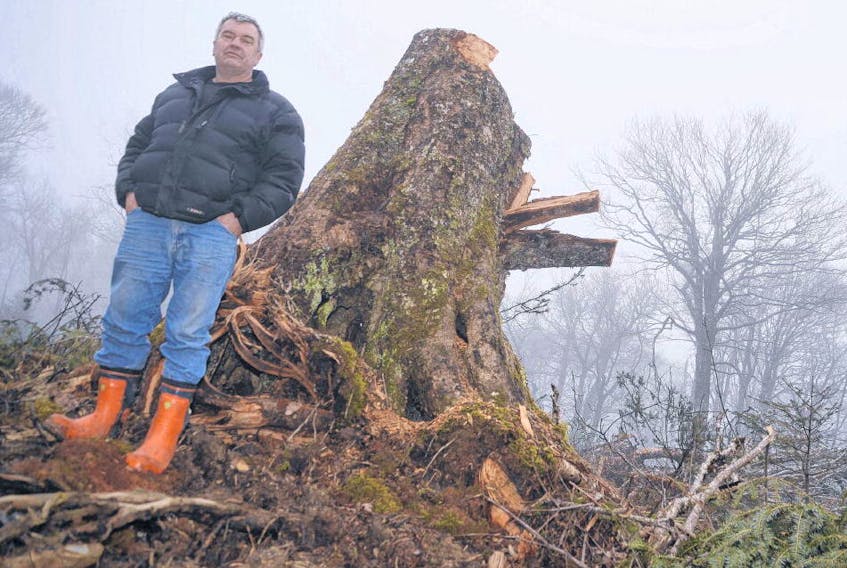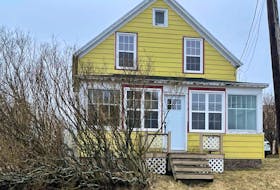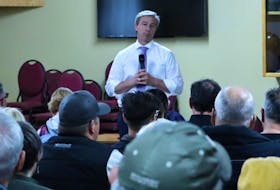The provincial government is admitting that an area of Crown land being cut primarily to support Nova Scotia Power’s biomass burner may include old-growth forest.
“We acknowledge the possibility of old forest or oldgrowth in there,” said Mark Pulsifer, regional resource manager for the Department of Natural Resources.
After Guysborough County harvester Danny George recently appeared on the front page of The Chronicle Herald accusing Port Hawkesbury Paper of cutting old-growth forest off Crown land to be burned for energy, Pulsifer’s department sent in its old forest specialist to analyze the area cut.
“We didn’t have any triggers to claim this is old growth until Mr. George brought it to our attention,”the regional resource manager said. “We’re trying to mobilize some people to do a reasonably thorough examination of that whole area.”
Following that initial investigation, the department is assembling a team to examine the entire area south of Salmon River that is
accessed by Loon Lake Road near Guysborough.
The revelation raises questions about how the department could not, as it claims, know what is being cut off the Crown land under its care.
In 2012, the province signed over management of all the Crown land in the seven eastern counties to Port Hawkesbury Paper.
The mill does what are called pre-treatment assessments of areas that it wants to cut and sends those in to the department, which is only mandated to check 10 per cent of sites before they are cut. Twenty-five per cent are checked after a harvest.
Provincial staff look at those assessments and compare them to forest-cover-type maps that estimate the composition of each stand of forest.
“In 2010, I told the regional forester for the Eastern Region that the maps were wrong and he agreed and said I should call in and report it to the Truro office,” George said.
“I called in and they laughed at me.”
On Tuesday, The Chronicle Herald took copies of the maps to five sites in the Loon Lake area that either have already been harvested or are proposed to be harvested.
At three of the sites, south of Loon Lake, Rocky Lake and at Three Ponds, the map named the primary species as shorter-lived red maple, when they actually appeared to be primarily old yellow birch.
Meanwhile, at two other sites, north of Loon Lake and at Eight Mile Lake, the maps’ estimates appeared to be correct.
Pulsifer said the maps are created using aerial surveys and the department knows there can be mistakes in them.
“When we have those situations where there are errors, our fallback is that
we have boots on the ground,” he said.
Port Hawkesbury Paper didn’t clearcut areas with mature hardwood forest in the Loon Lake area, Pulsifer said. Instead, the mill used a technique called group selection that sees less than 30 per cent of a stand cut so that it can regenerate.
However, those boots on the ground, who are trained by the department and paid by the mill, did not identify the potential for old-growth forest in the area around Loon Lake.
“We are using adaptive management,” responded Pulsifer.
“I am confident today that if the same people were going to go back in today, they would be able to identify (the potential for old growth).”
But Marven Hudson, district superintendent for Port Hawkesbury Paper, said identifying old growth is the province’s responsibility, not the mill’s.
“We don’t identify the old growth — the province identifies old growth,” he said. “We put our (pre-treatment assessments) into that program and it spits out what treatment we should do.”
Hudson said provincial staff receive the pre-treatment assessments, which include information on the stands’ maturity and species composition, and that it is up to them to visit the sites if they are concerned about old-growth forest.
Pulsifer said he didn’t think any department staff had visited the sites in the Loon Lake Road area that were recently cut or are destined to be cut.
On paper, the department is pretty clear about protecting oldgrowth forests. “The Old Forest Policy will conserve the remaining oldgrowth forests on public land and ensure that a network of the best old forest restoration opportunities is established,” reads the province’s policy document, passed in 2012.
According to the document a stand is considered old growth if:
• 30 per cent or more of the total volume of wood
in an area measured at breast height (known to foresters as the basal area) is composed of trees more than 125 years old;
• at least half the area is taken up by climax species — long-lived varieties of trees that require the shade of a forest canopy during their early years; and
• more than 30 per cent of the sky is blocked out by tree crowns.
On Tuesday, Pulsifer said the above description is a “minimum” for old growth and that his staff look for other things as well.
Asked if the department considered cutting old-growth forest to be acceptable, he said, “It can be, depending on where we are.”
Pulsifer said that because the province has already protected about 16 per cent of the land in that particular ecodistrict as old forest — above the required eight per cent — the department is able to allow some cutting in areas that could qualify as old forest.
According to a document provided by Port Hawkesbury Paper, of the hardwood it has cut in the area of Loon Lake Road, 73 per cent went for fuel wood (biomass), 11 per cent for firewood, eight per cent for hardwood pulp, six per cent for saw logs and a very small amount to make pallets.
Hudson said the mill will not cut a proposed site around Rocky Lake while the province investigates whether it qualifies as an old-growth forest.
The logging roads are currently closed in the area due to spring thaw, and no harvesting is happening until they reopen.









